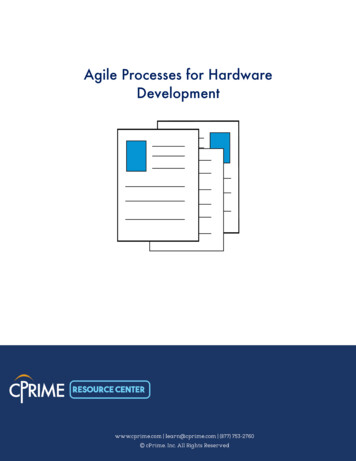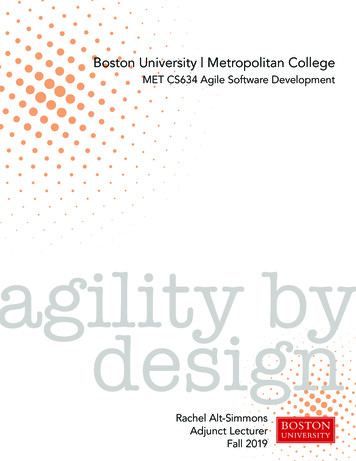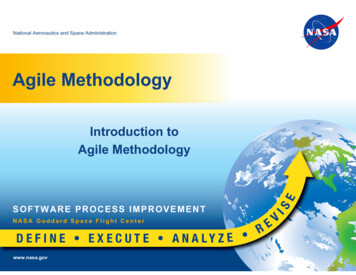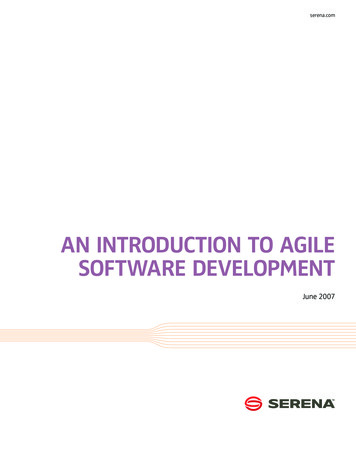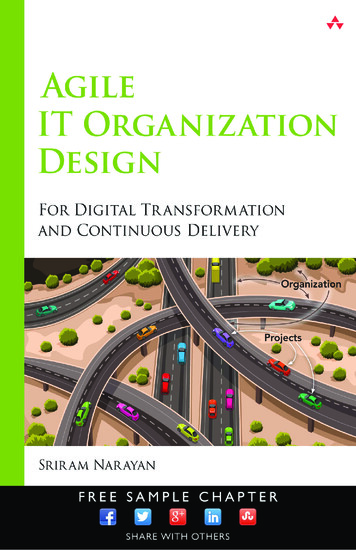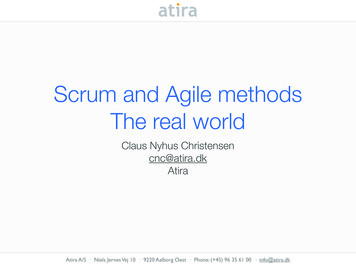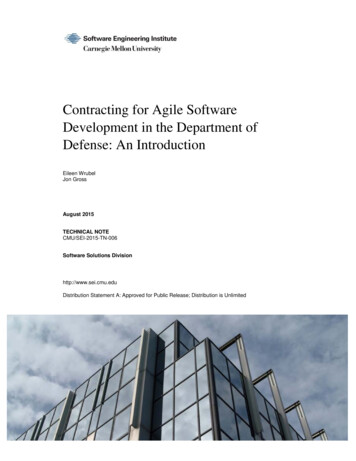
Transcription
Contracting for Agile SoftwareDevelopment in the Department ofDefense: An IntroductionEileen WrubelJon GrossAugust 2015TECHNICAL NOTECMU/SEI-2015-TN-006Software Solutions Divisionhttp://www.sei.cmu.eduDistribution Statement A: Approved for Public Release; Distribution is Unlimited
Copyright 2015 Carnegie Mellon UniversityThis material is based upon work funded and supported by the Department of Defense under ContractNo. FA8721-05-C-0003 with Carnegie Mellon University for the operation of the Software Engineering Institute, a federally funded research and development center.Any opinions, findings and conclusions or recommendations expressed in this material are those of theauthor(s) and do not necessarily reflect the views of the United States Department of Defense.References herein to any specific commercial product, process, or service by trade name, trade mark,manufacturer, or otherwise, does not necessarily constitute or imply its endorsement, recommendation,or favoring by Carnegie Mellon University or its Software Engineering Institute.This report was prepared for theSEI Administrative AgentAFLCMC/PZM20 Schilling Circle, Bldg 1305, 3rd floorHanscom AFB, MA 01731-2125NO WARRANTY. THIS CARNEGIE MELLON UNIVERSITY AND SOFTWARE ENGINEERINGINSTITUTE MATERIAL IS FURNISHED ON AN “AS-IS” BASIS. CARNEGIE MELLONUNIVERSITY MAKES NO WARRANTIES OF ANY KIND, EITHER EXPRESSED OR IMPLIED,AS TO ANY MATTER INCLUDING, BUT NOT LIMITED TO, WARRANTY OF FITNESS FORPURPOSE OR MERCHANTABILITY, EXCLUSIVITY, OR RESULTS OBTAINED FROM USEOF THE MATERIAL. CARNEGIE MELLON UNIVERSITY DOES NOT MAKE ANYWARRANTY OF ANY KIND WITH RESPECT TO FREEDOM FROM PATENT, TRADEMARK,OR COPYRIGHT INFRINGEMENT.This material has been approved for public release and unlimited distribution except as restricted below.Internal use:* Permission to reproduce this material and to prepare derivative works from this materialfor internal use is granted, provided the copyright and “No Warranty” statements are included with allreproductions and derivative works.External use:* This material may be reproduced in its entirety, without modification, and freely distributed in written or electronic form without requesting formal permission. Permission is required for anyother external and/or commercial use. Requests for permission should be directed to the Software Engineering Institute at permission@sei.cmu.edu.* These restrictions do not apply to U.S. government entities.Carnegie Mellon is registered in the U.S. Patent and Trademark Office by Carnegie Mellon University.DM-0002502Distribution Statement A: Approved for Public Release; Distribution is Unlimited
Table of ContentsAcknowledgmentsviiExecutive SummaryixAbstractxi1Introduction12What is Agile?2.1 The Agile Manifesto and Defining Principles2.2 A Definition of Agile Software Development2.3 Mapping of Manifesto to 12 Principles2.4 How Does Agile Differ from Traditional Software Development Methods?2.5 What Are the Benefits of Agile Methods?2.6 Further Reading4466711123The Contracting Officer, the FAR, and Agile3.1 Contracting Officers and the Acquisition Team: Definitions and Authority3.2 Stakeholder Objectives and Collaboration3.3 Flexibility to Innovate141416174Incremental Development in the DoDI 5000.024.1 Software Intensive Programs, Model Program 24.2 Incrementally Deployed Programs, Model Program 34.3 Tailoring is Expected Behavior191920215Agile/DoD Contracting: Addressing Common Misconceptions5.1 “Agile Doesn’t Produce Any/Enough Documentation”5.2 “Agile Methods Don’t Offer Enough Insight”5.3 “Requirements Are Too Nebulous with Agile, and That’s too Risky”5.4 “Frequent Iterations Create Significant Additional Contracting Overhead”5.5 “Agile Development Projects Are Not Aligned with Required Technical Reviews UnderDoDI 5000.02, so They Can’t Be Done”23232428306Contracting Approaches6.1 Contract Types6.2 Cost-Reimbursement Approach for Agile Contracts6.3 Firm-Fixed-Price Approach for Agile Contracts6.4 GAO on Effective Practices for Agile Contracting6.5 Future Work Needed3636383943447Summary4532Appendix A: Interview Questions46Appendix B: SEI Publications on Agile Software Development48Appendix C: DAU Guidance on Contract Type Selection50Appendix D: Agile Glossary53References57CMU/SEI-2015-TN-006 SOFTWARE ENGINEERING INSTITUTE CARNEGIE MELLON UNIVERSITYDistribution Statement A: Approved for Public Release; Distribution is Unlimitedi
CMU/SEI-2015-TN-006 SOFTWARE ENGINEERING INSTITUTE CARNEGIE MELLON UNIVERSITYDistribution Statement A: Approved for Public Release; Distribution is Unlimitedii
List of FiguresFigure 1:Agile Versus Waterfall Software DeliveryFigure 2:Agile Lifecycle [Palmquist 2014]10Figure 3:Differing Perspectives (Adapted from Hayes [Hayes 2014])16Figure 4:Model 2: Defense Unique Software Intensive Program [DoD 2015]20Figure 5:Model 3: Incrementally Deployed Software Intensive Program [DoD 2015]21Figure 6:Many Quality Touch Points in Agile Development [Hayes 2014]25Figure 7:Requirements and Approach, Traditional Versus Agile Software Development [U.S. CIO2014]29Figure 8:Marine Corps (MC)-Agile Increment 1,33Figure 9:Contract Type Applications37Figure 10:Value-Driven Projects [Opelt 2013]40Figure 11:Scoping and Process Definition for an Agile Fixed-Price Contract [Opelt 2013]42Figure 12:Detailing the Vision [Opelt 2013]43CMU/SEI-2015-TN-006 SOFTWARE ENGINEERING INSTITUTE CARNEGIE MELLON UNIVERSITYDistribution Statement A: Approved for Public Release; Distribution is Unlimited9iii
CMU/SEI-2015-TN-006 SOFTWARE ENGINEERING INSTITUTE CARNEGIE MELLON UNIVERSITYDistribution Statement A: Approved for Public Release; Distribution is Unlimitediv
List of TablesTable 1:Mapping of Agile Manifesto Tenets and Supporting PrinciplesTable 2:Differences Between Agile and Waterfall [Palmquist 2014]10Table 3:Sample Regulatory/Policy References [Hayes 2014]26Table 4:Agile Reviews and Traditional Reviews33CMU/SEI-2015-TN-006 SOFTWARE ENGINEERING INSTITUTE CARNEGIE MELLON UNIVERSITYDistribution Statement A: Approved for Public Release; Distribution is Unlimited7v
CMU/SEI-2015-TN-006 SOFTWARE ENGINEERING INSTITUTE CARNEGIE MELLON UNIVERSITYDistribution Statement A: Approved for Public Release; Distribution is Unlimitedvi
AcknowledgmentsThe Software Engineering Institute (SEI) has many points of support for the development of a research agenda on Agile acquisition. The SEI author team would like to express our appreciation toall those who took time out of their busy schedules to support this effort via interviews, introductions, or providing us with resources. Their contributions were invaluable to this process.We extend special thanks to the following individuals: Captain Daniel P. Taylor, United States Coast Guard (retired) Kelly Goshorn, former PEX Program Manager, Air Force Life Cycle Management Center/HBBD David I. Gill, Contracting Officer, Internal Revenue Service Brad Bernard, Deputy Chief Avionics Engineer, F-22 Modernization many additional contributors and supporters who prefer to remain anonymousThanks also go to our Agile Collaboration Group members, with whom we socialized and shapedthis project, and whom provided excellent discussion and feedback on the business issues surrounding contracting for Agile development. We also appreciate continued opportunities to exchange information and ideas through the Association for Enterprise Information (AFEI) eventsfocused on Agile in government.Finally, we extend our gratitude to our supportive colleagues Carol Sledge Jeff Thieret Rachel Callison, our fearless research and reference librarian Gerald Miller, our unfailingly patient editorCMU/SEI-2015-TN-006 SOFTWARE ENGINEERING INSTITUTE CARNEGIE MELLON UNIVERSITYDistribution Statement A: Approved for Public Release; Distribution is Unlimitedvii
CMU/SEI-2015-TN-006 SOFTWARE ENGINEERING INSTITUTE CARNEGIE MELLON UNIVERSITYDistribution Statement A: Approved for Public Release; Distribution is Unlimitedviii
Executive SummaryAs iterative, incremental, or Agile software development methods continue to gain traction in thesoftware industry, more and more Department of Defense (DoD) programs are taking notice ofthese methods, as a result of contractor proposals and program office staff research, outreach, andexperience. The DoDI 5000.02, published in 2015, discusses iterative software development[DoD 2015]. Differences between Agile development lifecycles and more traditional waterfallbased approaches surface throughout the lifecycle, requiring modifications to traditional milestones, documentation, delivery, and progress monitoring activities. Contracting professionals,however, generally do not receive professional career field training to guide them in developingcontracts that support these adaptations.This technical note (TN) is part of the SEI’s continuing exploration of Agile in the DoD. Ourprior efforts have focused on providing tools to program office teams for successfully implementing Agile methods. Throughout our data gathering for this paper, dozens of interviews conductedfor past efforts, our participation with various industry and academic groups, support to SEI customer programs, and our interactions with our own Agile Collaboration Group1 members, weheard a frequent refrain: program office teams do not feel that they “speak the same language” ascontracting officers with whom they must collaborate to create contracts that allow programs tofully realize the benefits of Agile methods, while simultaneously satisfying the contracting officer’s objectives of developing fair contracts that protect government interests at an acceptablelevel of risk while in compliance with federal statutory requirements and agency policy guidelines.This technical note, then, is intended primarily for contracting officers. The authors provide contracting officers with a basic background in Agile development principles, contrasting Agilebriefly with waterfall-based software development paradigms with which they may be familiar, asa means to set the stage for understanding how contracting deliverables and structures may needto adapt. We explore the Federal Acquisition Regulation (FAR) provisions that grant contractingofficers latitude to explore innovative business practices, and the collaborative support that shouldbe received from the program office team during the contracting process. We address the elementsof the 2015 DoDI 5000.02 that support incremental software development and the tailoring ofprogram activities, to allay concerns about newer lifecycle models.We address common concerns and misconceptions about risk associated with Agile development,supported with examples from actual programs and interpretive guidance from various federalagencies including the Government Accountability Office (GAO), the White House Office ofTechnology and Policy (OSTP), and the Office of Management and Budget (OMB). In each case,we provide contracting officers with concrete questions and actions that they can take to evaluateactions and deliverables proposed when developing a contract.1The Agile Collaboration Group is a consortium of more than 150 representatives from more than 45 organizations across the SEI, DoD, federal agencies, defense contractors, academic institutions, and private industry.CMU/SEI-2015-TN-006 SOFTWARE ENGINEERING INSTITUTE CARNEGIE MELLON UNIVERSITYDistribution Statement A: Approved for Public Release; Distribution is Unlimitedix
Finally, we address overall structure of contracts: there is considerable discussion within the Agilecommunity about whether fixed-price or cost-reimbursable structures are preferable for Agile. Wedo not attempt to divine a preferable approach: many variables affect the types of contracts thatcan legally be employed on any given program. Both approaches can produce viable contracts thateffectively deliver mission capability and provide appropriate insight into cost, progress, and software quality. Thus, we discuss both kinds of approaches and considerations that enable either typeto be used effectively.This paper is not intended to provide detailed guidance that applies to every situation, contractlanguage, or substitute for legal advice. Rather, the authors hope to provide contracting officerswith a “running start” when they encounter a program that will employ Agile methods.CMU/SEI-2015-TN-006 SOFTWARE ENGINEERING INSTITUTE CARNEGIE MELLON UNIVERSITYDistribution Statement A: Approved for Public Release; Distribution is Unlimitedx
AbstractThis technical note (TN), part of an ongoing Software Engineering Institute (SEI) series on Agilein the Department of Defense (DoD), addresses effective contracting for Agile software development. Contracting officers do not receive career field education targeted at achieving successfuloutcomes with Agile software development methods. For the purposes of this TN, the SEI gathered data from program office team members, contractors, and contracting officers about the stateof contracting activities involving Agile development. The authors conducted a series of interviews and mined past interviews and survey data on Agile software development to understandcommon questions and concerns and provide some real-world examples to address them. This TNoffers a primer on Agile based on a contracting officer’s goals, describes how program officeteams need to support contracting efforts, and addresses common concerns about Agile and howthose concerns can be mitigated in the contracting process.CMU/SEI-2015-TN-006 SOFTWARE ENGINEERING INSTITUTE CARNEGIE MELLON UNIVERSITYDistribution Statement A: Approved for Public Release; Distribution is Unlimitedxi
CMU/SEI-2015-TN-006 SOFTWARE ENGINEERING INSTITUTE CARNEGIE MELLON UNIVERSITYDistribution Statement A: Approved for Public Release; Distribution is Unlimitedxii
1 IntroductionIn recent years the federal government and the Department of Defense (DoD) have emphasizedthe necessity to shorten acquisition timelines to be more responsive to increasing operating tempoand warfighter need for more rapid capability development [OSD 2010, Lapham 2011]. In 2009,the Defense Science Board wrote that “The fundamental problem DoD faces is that the deliberateprocess through which weapon systems and information technology are acquired does not matchthe speed at which new IT capabilities are being introduced in today’s information age” [DefenseScience Board 2009].Additionally, requirements for any given system are highly likely to evolve between the development of a system concept and the time at which the system is operationally deployed as newthreats, vulnerabilities, technologies, and conditions emerge, and users adapt their understandingof their needs as system development progresses. Dr. Matthew Kennedy, formerly of the DefenseAcquisition University (DAU), wrote that “Previous experience shows that changes within an SIS[software-intensive system] are inevitable, whether or not there are changes in requirements ortechnology” [Kennedy 2011]. With budgets constrained, ops tempos increasing, and requirementsperpetually evolving, software development and acquisition practices must evolve in a way thatfacilitates faster capability deployment and flexibility in approaching system requirements.Iterative, incremental software development methodologies commonly referred to as “Agile”methods have been gaining ground in efforts throughout the DoD and federal agencies as a meansto achieving these objectives for the acquisition of software-intensive systems and improving visibility into development execution to enable early detection of problems that can derail programs.We have consistently written about cultural and behavioral shifts required on the part of programoffice teams and acquisition leadership to support the employment of Agile techniques [Lapham2010, Lapham 2011, Lapham 2014, Wrubel 2014]. DoD contracting officers and program managers, while fulfilling critical roles in the acquisition process, approach the issues of software-intensive system development through different lenses. A program manager is responsible for the development and delivery of a system that meets mission needs; a contracting officer is responsiblefor ensuring that the contractual vehicles employed to meet those mission needs are in compliancewith federal statutory requirements and agency policy guidelines. According to the Federal Acquisition Regulation (FAR) (Part 1.102-1 (b)),All participants in the System are responsible for making acquisition decisions that deliverthe best value product or service to the customer. Best value must be viewed from a broadperspective and is achieved by balancing the many competing interests in the System. Theresult is a system which works better and costs less [FAR 2015, emphasis added].Both program managers and contracting officers have different perspectives on “best value” as itpertains to their role in the process, and both must manage competing objectives such as risk (e.g.,technical, financial, information), cost, schedule, desires for flexibility versus desires for predictability, socioeconomic factors in contracting, and a wide variety of other factors. The contractingCMU/SEI-2015-TN-006 SOFTWARE ENGINEERING INSTITUTE CARNEGIE MELLON UNIVERSITYDistribution Statement A: Approved for Public Release; Distribution is Unlimited1
officer must ensure that while a contract is in the best interest of the United States government, italso provides “impartial, fair and equitable treatment”1 to contractors.Throughout the SEI’s multi-year efforts to address adoption enablers for and barriers to Agile inDoD programs, program managers and engineering staff have frequently indicated that putting effective contracts in place to support Agile methods remains challenging, citing a communicationbarrier with their contracting officer counterparts: “We don’t speak their language, and they don’tspeak ours.”2 In other words, program office teams are having difficulty communicating their“best value” scenarios and achieving alignment with the contracting officer’s “best value” scenarios.Currently, no formal Agile-related career-field education exists for DoD contracting officers.While Agile methods are explored in the curriculum at Defense Acquisition University, this iswithin the scope of IT career field coursework.3 Most of our respondents indicated that contracting officers assigned to their contracts had little or no prior exposure to Agile software development efforts and had little opportunity to receive training from other sources—many of themlearned “on the job” alongside their program office counterparts. Contracting officers with whomwe spoke mirrored this assessment—they had little to no professional exposure to contracting foriterative, incremental software development methods prior to being tasked with supporting theseacquisitions.With the understanding that contracting officers typically come across Agile “cold,” the purposeof this technical note is to introduce Agile concepts and principles to contracting officers and linkthose concepts and principles to supporting federal and DoD publications and elements of theFAR. Understanding the underlying principles and framework for Agile is necessary for an understanding of the level of specificity at which requirements are documented and the level of involvement of the program office in development activities, determining what deliverables are necessaryon a contract, and understanding how to monitor progress and quality of the software producedduring the contract. We also address common misperceptions about the risk associated with leveraging Agile methods on DoD contracts, and successful examples from real programs.The contracting community is a critical leader in the adoption of new innovation in the acquisitionof new capability or services for the DoD. The program manager is a key role, both in leading theprogram to meeting user/warfighter needs and helping the contracting officer establish effectivecontracts “that deliver the best value product or service to the customer” [FAR 2015]. The authorsintend to provide some initial knowledge of Agile methods and how they affect and are affectedby contracts, so that the contracting officer can help improve government business practices to ensure more effective delivery of capability. We also intend to provide program managers with perspective on the support contracting officers will require to develop effective contracts for Agiledevelopment.1FAR (Part 1.602-2)2Interview respondent3Reports from interview respondents, and also in AFEI 2012 Agile in Defense Fall Workshop [AFEI 2012]CMU/SEI-2015-TN-006 SOFTWARE ENGINEERING INSTITUTE CARNEGIE MELLON UNIVERSITYDistribution Statement A: Approved for Public Release; Distribution is Unlimited2
Section 2 provides the contracting officer with a basic understanding of Agile methods and howthe Agile lifecycle is different from traditional approaches.Section 3 delves into the role of contracting officers, program office teams, and the Federal Acquisition Regulation.Section 4 identifies elements of DoD acquisition guidance that support the implementation of Agile methods where appropriate.Section 5 addresses common misconceptions about Agile methods and provides contracting officers with both examples from real programs and questions contracting officers should pursue to setup contracts that will successfully leverage Agile efforts.Section 6 discusses how Agile methods can be supported using either fixed-price or cost-basedcontracts.The appendices to this document provide additional reference material on Agile software development in the DoD and the research questions that guided our interview efforts.CMU/SEI-2015-TN-006 SOFTWARE ENGINEERING INSTITUTE CARNEGIE MELLON UNIVERSITYDistribution Statement A: Approved for Public Release; Distribution is Unlimited3
2What is Agile?It is important to understand that Agile4 is not one specific method; Agile software development isboth a philosophy and an umbrella term for a collection of methods or approaches that share common characteristics.5 To arrive at a brief working definition, we must first introduce the underlying tenets and principles. (Appendix B of this document contains a list of additional SEI publications on using Agile methods in the DoD; Appendix D of this document contains a glossary ofcommon Agile terms used throughout this technical note.)2.1The Agile Manifesto and Defining PrinciplesThe Agile Alliance provides some background on the genesis of Agile methods:In the late 1990’s several methodologies began to get increasing public attention. Each hada different combination of old ideas, new ideas, and transmuted old ideas. But they all emphasized close collaboration between the programmer team and business experts; face-toface communication (as more efficient than written documentation); frequent delivery of newdeployable business value; tight, self-organizing teams; and ways to craft the code and theteam such that the inevitable requirements churn was not a crisis [Agile Alliance 2001c].A group of software industry practitioners and consultants, who became known as the Agile Alliance, developed and published key tenets known as the Manifesto for Agile Software Development [Agile Alliance 2001]:Manifesto for Agile Software DevelopmentWe are uncovering better ways of developingsoftware by doing it and helping others do it.Through this work we have come to value:Individuals and interactions over processes and toolsWorking software over comprehensive documentationCustomer collaboration over contract negotiationResponding to change over following a planThat is, while there is value in the items on the right,we value the items on the left more.4When using the term “Agile” throughout this paper, the authors refer to software development conducted according to principles and practices consistent with the Agile Manifesto and the Agile principles, using the definition provided in Section 2.2.5Palmquist offers a more thorough discussion of the similarities and differences between waterfall-based development and Agile development [Palmquist 2014].CMU/SEI-2015-TN-006 SOFTWARE ENGINEERING INSTITUTE CARNEGIE MELLON UNIVERSITYDistribution Statement A: Approved for Public Release; Distribution is Unlimited4
It is important to note that none of the elements on the right side of the list are absent; rather, theysupport and add value to the elements on the left side of the list: Tools and processes facilitate interactions between team members, as opposed to shoehorningthese interactions into molds and patterns for the sake of process compliance. Documentation is developed to add value to development and sustainment of the code, ratherthan as evidence to prove compliance or completion. Contract negotiations must establish a collaborative work environment that enables effectivedecision-making and flexible response, rather than high-overhead change control processes.(This can also include early termination points to limit government risk for poor performance.) High-level plans must be flexible to allow for necessary evolution of system requirements;plans become more granular at the development level.The Agile Alliance also documented 12 principles that underlie the tenets in the manifesto [AgileAlliance 2001b]:We follow these principles:1. Our highest priority is to satisfy the customer through early andcontinuous delivery of valuable software.2. Welcome changing requirements, even late in development. Agileprocesses harness change for the customer's competitive advantage.3. Deliver working software frequently, from a couple of weeks to acouple of months, with a preference to the shorter timescale.4. Business people and developers must work together dailythroughout the project.5. Build projects around motivated individuals. Give them the environment and support they need, and trust them to get the jobdone.6. The most efficient and effective method of conveying informationto and within a development team is face-to-face conversation.7. Working software is the primary measure of progress.8. Agile processes promote sustainable development. The sponsors,developers, and users should be able to maintain a constant paceindefinitely.9. Continuous attention to technical excellence and good design enhances agility.10. Simplicity—the art of maximizing the amount of work not done—isessential.11. The best architectures, requirements, and designs emerge fromself-organizing teams.12. At regular intervals, the team reflects on how to become more effective, then tunes and adjusts its behavior accordingly.CMU/SEI-2015-TN-006 SOFTWARE ENGINEERING INSTITUTE CARNEGIE MELLON UNIVERSITYDistribution Statement A: Approved for Public Release; Distribution is Unlimited5
With this basic understanding of the philosophy of Agile development, we can move on to understanding what happens in practice. This understanding will provide a foundation for understanding how the Agile-based development model behaves differently from traditional waterfall-baseddevelopment models, and how those differences manifest themselves in program execution.2.2A Definition of Agile Software DevelopmentDistilling the guidance from the tenets of the manifesto and the 12 supporting principles, one soliddefinition of Agile isAn iterative and incremental (evolutionary) approach to software development which is performed in a highly collaborative manner by self-organizing teams within an effective governance framework with “just enough” ceremony that produces high quality software in a costeffective and timely manner which meets the changing needs of its stakeholders [Ambler2004].We can extend this definition by describing the behavior of an Agile team, as follows:In Agile terms, an Agile team is a self-organizing cross-functional team that delivers working software, based on requirements expressed commonly as user stories, within a shorttimeframe (usually 2-4 weeks). The user stories often belong to a larger defined set of storiesthat may scope a release, often called an epic. The short timeframe is usually called an iteration or, in Scrum6-based teams, a sprint; multiple iterations make up a release. The team’sprogress toward completion of the iteration is measured via the team’s velocity. While thecode produced within an iteration is useable, it may not have enough functionality to be released to the end user until the multiple iterations that make up a release are completed[Lapham 2011].Agile methods involve successive iterations of software development, each iteration producingworking software, and enough documentation to develop and support the associated code base.Understanding how Agile teams produce code allows us to understand how acquisition and contracting guidance must be adapted.Throughout the rest of this paper, when using the term “Agile,” the authors refer to software development conducted according to principles and practices consistent with the Agile Manifestoand the Agile principles, using the definition provided in this section.2.3Mapping of Manifesto to 12 PrinciplesWe can map the tenets of the Agile Manifesto to the 12 supporting principles (some principles aremapped more than once). Items highlighted in bold italic in Table 1 are of special note for contracting officers and are themes consistently addressed throughout this technical rumCMU/SEI-2015-TN-006 SOFTWARE ENGINEERING INSTITUTE CARNEGIE MELLON UNIVERSITYDistribution Statement A: Approved for Public Release; Distribution is Unlimited6
Table 1:Mapping of Agile Manifesto Tenets and Supporting PrinciplesTenetsPrinciplesIndividuals and interactions overprocesses and tools4. Business people and developers must work together dailythroughout the project.5. Build p
As iterative, incremental, or Agile software development methods continue to gain traction in the software industry, more and more Department of Defense (DoD) programs are taking notice of




